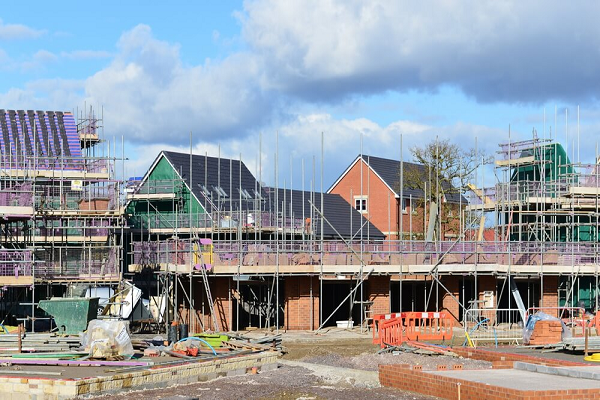Adding Value to Your Home before it Goes on the Market
For many people, their home is their largest and most important investment. Selling a home is a big decision, and it usually takes time and a significant amount of money to make the transaction final. Before your home goes on the market, you can do several things to increase its value. The good news is that these are generally things that are easy to accomplish with a little bit of time and money. When working with a real estate professional, there are a lot of things that they can recommend to make the process easier. For most people, you should budget up to ten per cent of your home for closing costs and other expenses. This is why getting the most out of your home is so important.
Landscaping is a great start
One of the easiest ways to improve the look and feel of your home is through landscaping. Investing in the look around your home can greatly increase the chances of you getting a top price for your home. For a small amount of money invested, you can add ten or twenty per cent to the purchase price of your home.
Get scrubbing!
New homeowners want the home to look clean and tidy on both the inside and outside. Many young families with pets also prefer that a home have a nice fence in the backyard. If you have siding on the outside of your home, make sure it looks freshly painted. Although this seems like a small thing to look at, it can really make your home stand out to new buyers.
Initial price
The initial price that you put your home on the market for is of utmost importance. Over the long term, this can really make your home stand out to new buyers. Never try to price your home too high for the market. Not only does this create a lot of issues for you, but it will make the home sit on the market longer than you would like. Many professionals advise that you figure out what the market value is and price it just below that point. Not only will this make selling your home faster, but it will make it much more convenient as well.
Negotiating is a skill
When it comes to negotiating, you need to make sure that you have multiple people interested in the property. This is why the pricing strategy already outlined makes so much sense. Over the long term, having a quick sale on your home is well worth the few thousand pounds that you take out of the purchase price of the home. With multiple people interested in buying the home, you are able to use leverage and make them pay more than they would otherwise. Overall, selling a home is a huge financial investment. It only makes sense that you spend the appropriate amount of time and money to get as much out of your home as possible.
Flipping Homes for Profit
The real estate market is hot in many areas of the country today. With that being said, there are a lot of opportunities to invest in various areas of the economy. Flipping homes has long been a great way to get started investing in real estate.
Although it sounds easy, there are a lot of things to keep in mind about this process. Not only that, but it can carry a lot of risk for your financial situation if you do not do your research. If you are going to flip a home for profit, there are several things that you need to keep in mind during this process. Not only do you need to spend your time finding a great deal, but you also need to work with a quality team on selling the property.
Finding a deal
When it comes to real estate, most of the money is made on the purchase. If you can purchase a property at a discount, you are well on your way to increasing your overall wealth. A lot of people today are excited about the changes that are taking place in the industry. Not only are homes selling faster than ever before, but they are going for more than the list price. This is why flipping homes is so appealing. In a rising real estate market, it can seem easy to make a lot of money. However, you need to work with a quality realtor who can help you find a home for a great deal. During the process, they can educate you on the types of homes that make the most sense for your financial situation.
Upgrading a home
One of the fun parts of flipping a home is the upgrading portion. Many investors will buy a home in need of repair and spend a significant amount of time and money upgrading it. The hope is that the overall value of the home will increase more than the amount of money that was put in to get it to the next level. If you do not have experience in this area, you need to make sure you are careful with the upgrades that you decide to invest in. A lot of people today are excited about the changes that are taking place in the industry, but that does not mean to rush into something just because you think it is an easy way to make money.
Planning for the future
Overall, investing in real estate can be a great way to make money. However, you need to make sure you have a quality plan in place to do so. Over the long term, a lot of people have decided to start investing in a variety of areas in this market. If you want to flip a home quickly, you need to make sure it is upgraded and priced to sell. There are many people who are excited about the changes that are being made to the business, and you can profit from them if you work hard and do your research.
An Overview to Property Refurbishment and Barn Conversions
To take a look at the way in which bridging loans are used to create profit in the field of property development, we spoke with James Stevenson, who has 20 years of experience, about some first-hand experience about what is involved in the conversion process that earns the development company profit.
This is what James had to say. Over the years, we have worked on many refurbishment projects, but one of the most memorable ones we worked on was the classic “barn conversion” in 2005 in Brighton. This was one of the most interesting projects we worked on due to the fact that we literally started with what can be explained as a blank sheet.
When we first got to the site, the wall was weak and could react to gentle pressure. The cement was very old and unstable. Our immediate reaction was to look up (in case the roof fell in), and we prepared ourselves to get out of the way just in case it did. What a job it was! However, it turned out we really enjoyed it in the end (as did the client who funded the whole conversion), for the following reasons:
The conversion process
For argument’s sake, we sorted out the architect’s plans and got all the planning permissions through before we engaged in the transformation of this old backstreet relic into the top-class luxury home we envisioned. After the planning was in place, we presented the appropriate information to the client and got the go-ahead to begin.
It is pertinent to note that the client was funding the whole process, so of course he had to know what the budget was and the time period we were aiming for, as well as the shortfall short fall of the programme time limits. In every scenario, we had a failsafe curtain that involved contingency plans around every corner. Thus, if there was an issue that held up the projected plan, it would be addressed financially.
There is a document, but it can be commonly known as a notary agreement where both parties understand and confirm that these are the parameters of the agreement that they will adhere to, and if such a shortfall occurs, there will be a financial clause that comes into effect.
Steps in the design process
First days on the job and planning are the keys to organising the first steps. When the overall concept is conceived, the building begins. We took the soil floor and laid the concrete screed into position, levelling the base for the build.
Next was screeding the floor, which set the level for the first-floor height. Measuring from the floor, we set the joist hanger positions correctly using “Chemfix bolts into the walls” to secure the first-floor infrastructure into place.
(Source: wikihow.com/Screed-a-Floor)
Joist hangers were put into place so that the first floor could be constructed, ready to build from. Then the stairs were put in, and the boarding was installed, forming the upper section of the property.
Once this was laid out, separate compartments were put into place in the bedrooms, bathroom, hallway, and so on. As the lower section of the ceiling was not yet boarded, the electricity and pipe work were installed so all the associated could then be connected up in situ.
Planning is everything on a job like this. Overboarding downstairs was completed together with plastering, ready to decorate later. Next was the installation of the stairway into position so the upper floor boarding could begin.
Know what you want to do
Pipework needed to be laid into place, along with the inflow and outflow of soil pipes needed for the fitting of both kitchens and bathrooms together.
Plans and designs understood that layouts were essential, so all the trades knew exactly what the outcome required was and how to implement the jobs at hand. Managing the trades (for a foreman or site manager) is seriously essential work, as any mistake costs money. If things are managed correctly in the first place, then the rest should fall into place on time and, above all, on budget.
Forward planning
Once you have a grasp on the requirements, materials are ordered as required in the correct order. There is little point in bringing in the trades or professions when they do not have the base materials to work with, and again, planning is the key to all of this. Everything must be pre-organised and ready on site to get on with the job, ready to start the process from the start. Time is money, and planning is the key to everything.
The upper floor layout was positioned with bedrooms, toilets, bathrooms, etc. all put into place and fitted as per the specifications detailed on the plans. The client was overseeing all the steps involved, so if there were any issues, they were picked up ASAP and dealt with accordingly.
Funding and confidence
All the funds were in place, ready to go ahead, so now it is of the essence to keep to the schedule. A bridging loan had been raised to complete work, so we were on track for completion within the two-month period set to complete the entire project.
As Nick Marr Property Development Expert points out, “With any barn conversion or conservatory design, it is important to get everything right from the start, so the job runs smoothly and will be completed in the specified time frame, first time, which obviously eliminates costly mistakes and delays overall.”
Conclusion
The above is a brief outline of the steps involved and the mental set of actions needed to get a very basic grip on such a project from the outset.
We hope this write-up was of help to you in the learning or other processes. Property development is a thorough and exacting process. You need to know what you are trying to do and how you set about doing it, from the smallest consideration to the end result. If you have put into play financial backing, then it is vital that you finish the project on time; otherwise, you risk the penalty clause agreed to when taking out the loan.
Government Assistance Doing Little to Help Smaller Builders
An industry study has revealed that despite ongoing efforts from the government to boost the sector, SMEs in the construction industry are struggling to access funding. Housing supply has been a firm priority point for the government for several years now, as affordable inventory in the UK continues to dwindle. Nevertheless, the inability to access funding is making it difficult for smaller housebuilders to make any real difference to the bigger picture.
The report, published last week by the Federation of Master Builders, detailed how more small and medium-sized builders are facing problems accessing funding this year than they were in 2016. Whereas around 50% pinpointed difficult access to funding as a significant roadblock last year, this has now increased to 54% for 2017.
“Almost a decade after the financial crisis, access to finance for small house builders is getting worse instead of better,” commented Brian Berry, chief executive of the FMB.
The details of the report paint a picture of an ongoing governmental push to improve and expand the housing sector that simply isn’t working. Several schemes and policies have been rolled out over recent years, one of which is the £3 billion Home Building Fund, which was created specifically to assist this part of the sector.
According to the Housebuilders’ Federation, approximately 12% of British homes were built by SMEs last year, equating to around 20,000 properties. Over the past 25 years, the number of SME housebuilders operational in the UK has declined by around 80%. While it had been expected that things would begin to show signs of turning around following the financial crisis, evidence would seem to suggest this simply wasn’t the case.
As of 2015, no more than around 1 in every 8 homes built across the country was the work of SMEs, suggests a report published by the HBF. If things were taken back to their 2007 standards, this would result in around 25,000 more annual home developments from this part of the sector alone.
Back in February, the government published a white paper affirming its commitment to the SME construction sector, though the inability to access funding continues to stand in the way of many.
“The White Paper quite rightly emphasises the need to diversify the housebuilding sector, so it is less reliant on a few large house builders. To do this, we need the government to make good on its proposals to improve the availability of small sites and speed up the planning process for small sites,” Mr Berry stated.
In turn, a growing number of developers have begun turning to alternative financial products and solutions, development-bridging loans, having seen a significant spike in popularity. Intelligent financial solutions tailored to the needs of the property sector are becoming an important lifeline for hundreds of businesses up and down the country.
For more information on bridging loans and alternative financial solutions for property development and construction, get in touch with the UK Property Finance customer service team today.
Development Finance In Greater Need As Two Thirds Of Adults Prefer Brand-New Properties
It’s becoming clear that, as far as the average would-be home buyer in the UK is concerned, one type of property takes precedence over all others. We’re not talking about the size, shape, or specification of the property either, but rather the all-important matter of whether it’s new. While it may not necessarily be within the financial means of all home buyers, it seems that new-build properties represent the properties of choice for the vast majority.
According to the results of a new survey carried out by the Skipton Building Society, two in every three home buyers prefer the idea of moving into a brand-new property. Along with this, 38% of respondents said that they would love to have their new home built from scratch to their own specifications, if money wasn’t an issue.
When quizzed further on their reasons, more than half of those who favour new-build properties cited their primary explanation as being able to decorate and personalise the place to their own tastes prior to moving in. Interestingly, around 45% stated that they would not even consider a property that was more than 46 years old, while over 20% said that they would be far less likely to buy a property if they knew that a person had died in it at any time.
Speaking on behalf of Skipton Building Society, communications manager Rebecca Willey talked of the reasons why new homes seem to be appealing to more would-be buyers than ever before.
“It seems it’s not just the unexpected costs associated with buying an older home that is scaring the nation; a fear of ghosts, mysterious property pasts, and even dead pets buried in the garden are enough to put people off buying an older house,” she said.
“While it may spook some, purchasing an older property full of historical charm is a real treat for others.”
“However, it’s not hard to see why so many people want a new-build home, as they provide an opportunity to create the home of your dreams without the hard work and baggage from previous owners.”
For those on the business end of the spectrum, such demand paints a picture of a golden era for those working in property development. Demand for high-quality new-build properties of an affordable nature is accelerating at a previously unseen pace, all across the United Kingdom. For many developers, simple financial restrictions or challenges in sourcing capital at the opportune moment can stand in the way of what could be an incredible opportunity.
The team at ukpropertyfinance.co.uk specialises in intelligent, affordable, and immediate financial solutions for all property development purposes. By removing the complications and red tape associated with major banks and lenders, gaining access to essential funding when and where it is needed has never been easier.
Development Finance – Bridgingloans.co.uk have the experience
The last six months have seen a marked upturn in lenders’ willingness to fund property development deals, from small refurbishment projects to multi-million-pound new-build developments. At Bridgingloans.co.uk, we have been able to take full advantage of this volume increase due to our expertise in the marketplace.
Recently completed deals have highlighted just what issues can arise:
- On a small barn development, it was found at the 11th hour that the client’s insurance did not cover her for the full risks involved, and the lender would not draw the funds. Solution: We introduced our specialist development insurance broker, who quickly assessed the problem and provided the cover required in a timely manner to enable drawdown.
- During the valuation stage of a mill purchase in the North of England, the valuer identified a potential environmental risk and (quite rightly) requested a specialist report. The client looked around and obtained quotes in excess of L2,000. Solution: Through our network of specialists, we quickly identified the most appropriate local environmental specialist who completed the report in less than 10 days and at a fraction of the costs previously quoted.
- We were approached by a local property developer who wanted to reinstate the build of a site mothballed back in 2008. His issue was that his existing bank was on the verge of appointing receivers due to the dormant position on the site. Solution: BridgingLoans.co.uk were able to source a lender who agreed to both the take-out of the bank and provide the development finance and funding required. In addition, we maintained constant contact with the existing bank, which ensured the receivership was put on hold, which allowed the refinancing to take place.
In each case above, the ability to quickly identify and resolve the issues enabled the loan process to continue and lead to the completion of the case.
Through the experience of the team, we can quickly resolve the majority of issues that invariably happen during any development deal and reassure the clients that we can help overcome the problems. For both first-time and experienced developers, this added value makes ukpropertyfinance.co.uk the ideal choice.
Increased Involvement In Development And Renovation Finance
In the last few months, UK Property Finance has substantially increased its involvement in locating the funds needed to cater for the surging demand for development and major renovations requiring finance. UK Property Finance, which is a trading style of Penuptra Consulting Ltd., is a directly FCA-authorised and regulated business focusing almost entirely on niche area funding. The company has an enhanced reputation of being a “one-stop” financial shop where brokers and members of the public alike can, with one simple telephone call or email, access a wide range of property-related finance expertise and money. The offering includes brokering for residential, commercial, BTL, and equity release first charge mortgages, secured second and third charge loans, general insurance products, and first, second, and third charge, etc., regulated and unregulated bridging loans that can be secured on solely or a mix of land, property, or commercial units.
As part of its drive into the development funding arena, UK Property Finance has in recent months become involved in a multi-apartment, mixed-use, 3-stage development on the south coast of England. The client, a recently formed limited company where the directors have a huge amount of experience and specialise in obtaining planning permission for difficult sites and projects, agreed to a purchase price for the brownfield site, subject to eventual planning approval. They then spent the next 2 years putting in much time, effort, and money to obtain formal approval. With the planning now agreed upon, the value of the land had increased substantially, way beyond the price our client had originally agreed to pay the seller, and as such, this made the proposal very advantageous to our client, and, as you would have thought, many lenders. Our client then trawled through the normal high-street bank culprits in an attempt to locate the development finance required to complete the project before selling the already pre-sold units, but unfortunately, for one reason or another, our client was rejected.
Luckily, UK Property Finance was then recommended to our client via his local bank. Due to the increase in valuation, we submitted the case to one of our large and varied panel of commercial lenders and managed to enable the size of the purchase loan available to be based on the actual valuation of the land (with planning), not the purchase price (which was without planning). This pretty much meant that our client, who had already spent a substantial amount of time and money obtaining the planning permission, could now purchase the land without any further down payment from themselves.
The achievement of planning also increased the land value to such an extent that our client required minimal remaining financial input to complete the build prior to the properties being sold off to pre-agreed purchasers.




 0116 402 7982
0116 402 7982






